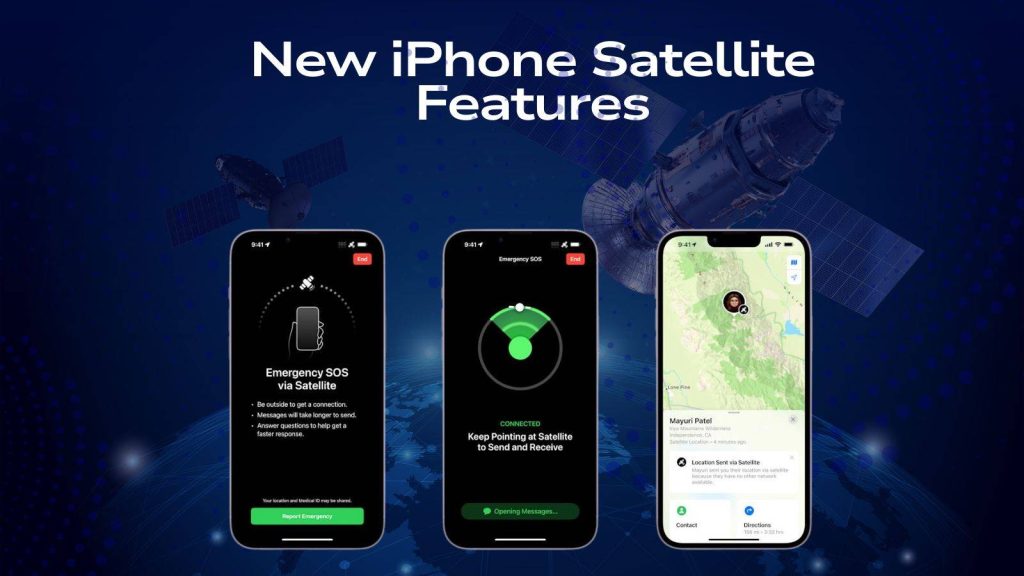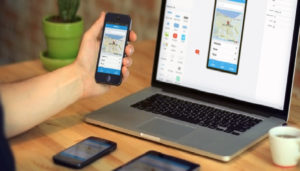Apple has always been at the forefront of mobile innovation, continually pushing the limits of what a smartphone can do. One of the most exciting areas Apple is currently exploring is satellite technology. With the upcoming updates, iPhones could soon offer connectivity beyond traditional cellular networks, bringing unprecedented capabilities to users worldwide.
Find five new iPhone satellite features Apple is working on, providing a detailed look at each innovation, their potential uses, and why they matter for both everyday users and adventurers alike.
Apple’s Satellite Innovations in iPhone
Apple’s exploration into satellite technology is a game-changer for the smartphone industry. Traditionally, iPhones rely on cellular towers and Wi-Fi for connectivity. These signals are often limited in remote or rural areas. To solve this challenge, Apple is developing features that integrate satellite connectivity directly into the iPhone.
This integration opens new possibilities: users could send messages, share locations, or even access limited data services where previously impossible. Apple’s approach emphasizes safety and convenience, making the iPhone not just a communication tool, but a device that ensures connectivity even in life-threatening situations.
Development of iPhone satellite features also reflects Apple’s larger strategy to differentiate its devices in a highly competitive market. By combining advanced hardware, software optimization, and seamless user experience, Apple is preparing to offer capabilities that no other smartphone currently provides. This innovation is particularly relevant for travelers, outdoor enthusiasts, and professionals working in remote areas.
5 Game‑Changing iPhone Satellite Features
Find all the details about 5 game-changing iPhone satellite features that enhance safety, communication, and navigation. Get insights on Emergency SOS, satellite messaging, real-time location sharing, and more beyond cellular coverage.
1. Emergency SOS via Satellite: Staying Connected in Critical Moments
One of the most anticipated iPhone satellite features is the ability to send an Emergency SOS via satellite. Currently, iPhone users can make emergency calls through cellular networks, but these calls fail in areas with poor or no coverage. Apple’s satellite SOS feature directly addresses this critical limitation, providing users with a reliable lifeline in remote locations.
The system works by connecting the iPhone directly to satellites orbiting Earth, allowing users to transmit SOS messages when traditional networks are unavailable. Apple has optimized this feature to use minimal bandwidth, ensuring messages reach emergency services quickly. The user interface will guide users to point their device toward a satellite for maximum signal strength, making the process intuitive, even for those unfamiliar with satellite technology.
Additional advantages include:
- Automatic Location Sharing: When sending an SOS, the iPhone can transmit precise coordinates to emergency responders, reducing response time and increasing the likelihood of timely assistance.
- Message Prioritization: Messages are compressed and prioritized to ensure delivery, even under bandwidth constraints, guaranteeing that critical information reaches responders first.
- Global Coverage: Unlike terrestrial networks, which are limited by geography, satellite connectivity can reach virtually any remote area on Earth. Apple aims to provide functionality worldwide, giving adventurers, travelers, and sailors peace of mind wherever they are.
- User-Friendly Guidance: Interactive instructions on-screen will help users align their iPhone to satellites for optimal connection, making it accessible even for first-time users in stressful situations.
This feature is expected to be a lifesaver for hikers, sailors, travelers, and anyone frequently off the grid, eliminating the need for specialized emergency beacons or additional devices. It represents a major step forward in personal safety and global emergency preparedness.
2. Satellite-Based Messaging: Text Anywhere Without Cellular
Another key iPhone satellite feature Apple is developing is satellite-based messaging, allowing users to send text messages even in areas without cellular coverage. This capability could be revolutionary for outdoor enthusiasts, adventurers, and travelers exploring remote regions.
Apple plans to optimize the system for short messages, ensuring reliable communication despite limited bandwidth. While the initial rollout may focus on basic text and alerts, future updates could expand to include small data packets, location updates, multimedia notifications, and status check-ins.
Potential benefits include:
- Remote Communication: Hikers, campers, sailors, and explorers can maintain contact with loved ones even in regions where cellular networks fail. This provides peace of mind and a continuous link to the outside world.
- Enhanced Safety: In emergency situations or unexpected travel disruptions, users can alert friends, family, or authorities without delay. This reduces the risk of becoming completely stranded or isolated.
- Seamless Integration: Apple is likely to integrate satellite messaging with existing apps like iMessage, Mail, or Find My, allowing users to communicate naturally without learning new apps or interfaces.
- Minimal Data Requirements: By designing the feature to work with tiny packets of data, Apple ensures messages can be sent quickly even in adverse conditions, such as heavy cloud cover or obstructed terrain.
By leveraging satellite messaging, Apple ensures that users are never truly disconnected, bridging the gap between traditional cellular networks and full global connectivity.
3. Real-Time Location Sharing Over Satellite
Real-time location sharing is another critical iPhone satellite feature with tremendous potential. Current location-sharing tools rely heavily on cellular or Wi-Fi networks, which can fail in remote or off-grid locations. Satellite-based sharing overcomes these limitations, providing reliable, global tracking capabilities.
With this technology, iPhones could transmit exact location data anywhere on the planet, offering unmatched precision. Benefits include:
- Outdoor Adventurers: Hikers, climbers, and campers can share live location updates with friends, family, or emergency teams, enhancing safety during remote expeditions.
- Travelers: When traveling internationally or in areas with unreliable cellular coverage, users can ensure their location is known, minimizing the risk of getting lost or stranded.
- Emergency Situations: Rescue teams can locate lost or injured individuals faster with precise satellite data, dramatically improving response times.
- Integration with Apple Maps: Apple may enhance this feature by combining satellite location sharing with navigation tools, allowing users to plan safer routes, receive real-time hazard warnings, and track journey progress accurately.
- Predictive Safety Alerts: By leveraging satellite data, the iPhone could potentially warn users about environmental dangers such as sudden weather changes, steep terrain, or isolated regions with no nearby help.
This feature turns the iPhone into a comprehensive safety companion, particularly for those exploring uncharted or less-traveled areas.
4. Satellite Data for Outdoor Adventures & Travel
Apple’s satellite capabilities extend beyond communication and safety, offering exciting opportunities for enhancing outdoor adventures and travel experiences. With satellite data, users can access real-time navigation, weather updates, route optimization, and environmental alerts in areas without cellular service.
Key applications include:
- Improved Navigation: Real-time satellite data can provide highly accurate mapping even in rural or off-grid locations, assisting hikers, cyclists, and explorers in reaching their destinations safely.
- Weather Alerts: Satellite connectivity allows users to receive timely weather warnings, including storms, floods, or extreme temperature conditions, crucial for travelers, sailors, or outdoor adventurers.
- Activity Tracking: Users can monitor their route, speed, elevation, and progress without relying on cellular signals, enabling better planning and performance tracking for outdoor activities.
- Seamless Integration with Apps: Apple may integrate these features into apps like Maps, Compass, and Health, providing a complete experience that combines navigation, fitness, and safety tools.
- Adventure Planning: Future updates could allow satellite-fed recommendations for hiking trails, scenic routes, or safe camping spots based on current location and environmental conditions.
Apple’s goal is to make the iPhone a comprehensive tool for exploration, blending technology, convenience, and safety into a single device.
5. Future Satellite Services: Beyond Communication
While the initial focus is on messaging, SOS, and location tracking, Apple’s long-term vision for satellite integration may include advanced services that redefine global connectivity.
Potential future developments include:
- Satellite Internet: Limited browsing, email access, and data usage even in remote locations without cellular networks, allowing continuous connectivity during travel or emergencies.
- Global Environmental Data: Real-time access to weather, climate alerts, natural disaster warnings, and other location-based information directly on the iPhone.
- Enhanced Logistics & Tracking: Businesses could leverage satellite connectivity for tracking shipments, monitoring remote operations, or managing resources in regions where traditional networks are unavailable.
- Developer Opportunities: By opening APIs for satellite features, Apple could empower third-party developers to create apps that utilize satellite connectivity for adventure, safety, environmental monitoring, or even gaming.
- Scalable Satellite Ecosystem: Apple is likely building a long-term satellite infrastructure that grows over time, allowing additional services such as global IoT device connectivity, wildlife monitoring, and remote scientific research.
By investing in satellite technology, Apple is positioning itself as a pioneer in global connectivity, offering solutions that go far beyond personal communication and opening new possibilities for innovation across industries.
FAQs
1. What capabilities do iPhone satellite features offer?
iPhone satellite features provide emergency SOS messaging, real-time location sharing, and basic satellite-based communication. They allow users to stay connected in areas where cellular networks are unavailable.
2. How does Apple ensure global coverage for satellite features?
Apple leverages low-earth orbit satellites to maintain connectivity worldwide. These satellites allow iPhones to transmit messages and share locations even in remote or rural regions where cellular networks cannot reach.
3. Do iPhone satellite services require additional hardware or subscriptions?
Apple integrates satellite capabilities directly into select iPhone models, eliminating the need for external devices. Subscription requirements, if any, will depend on Apple’s service plans, which may cover messaging and emergency features.
4. How reliable is satellite messaging in emergency situations?
Apple optimizes satellite messaging for speed and reliability. SOS messages are compressed and prioritized, ensuring that critical communications reach emergency responders efficiently, even under low-bandwidth conditions.
5. Can users utilize satellite features in urban environments?
Yes, iPhone satellite features function in cities, but Apple recommends open areas with minimal obstructions for optimal connectivity. Tall buildings and dense infrastructure may reduce signal quality.
6. What privacy measures protect iPhone satellite communications?
Apple encrypts all satellite communications end-to-end. Users control when and how location or emergency data is shared, ensuring sensitive information remains secure and private.
7. Are older iPhone models compatible with satellite features?
Apple designs satellite capabilities for newer iPhone models with specialized antennas and hardware. Older models cannot support these features due to technical limitations.
8. How does using satellite features affect battery life?
Satellite usage consumes more battery than standard cellular functions, especially when actively searching for satellites. Apple optimizes energy consumption, but extended use may reduce overall battery performance.
9. How does satellite SOS differ from conventional emergency calls?
Satellite SOS functions even when cellular networks fail. It transmits exact GPS coordinates and compressed messages to emergency responders, improving response times and safety in remote areas.
10. Does Apple plan to expand satellite services beyond messaging and SOS?
Yes, Apple envisions future satellite services, including limited internet access, environmental alerts, and support for business logistics in remote locations. These advancements aim to extend global connectivity and enhance user safety.




